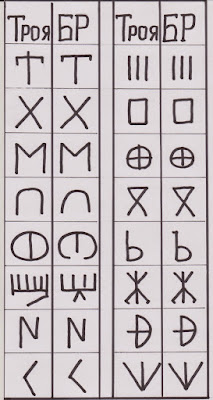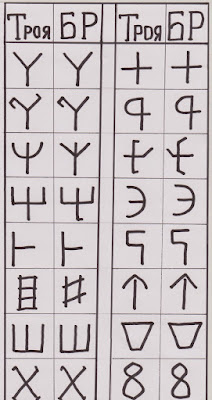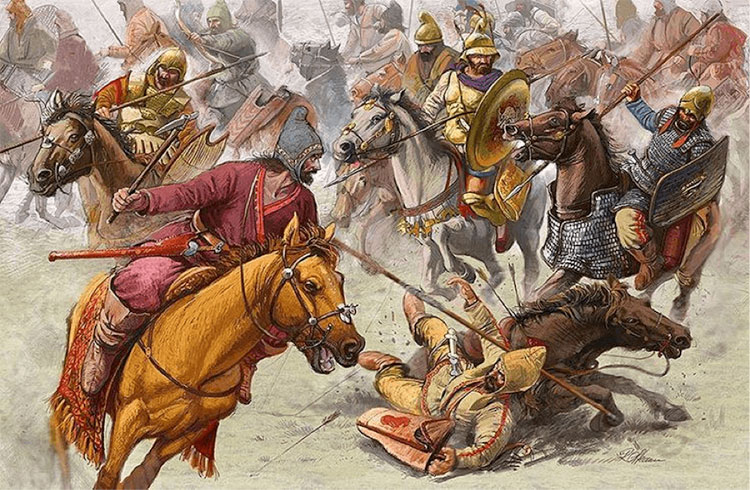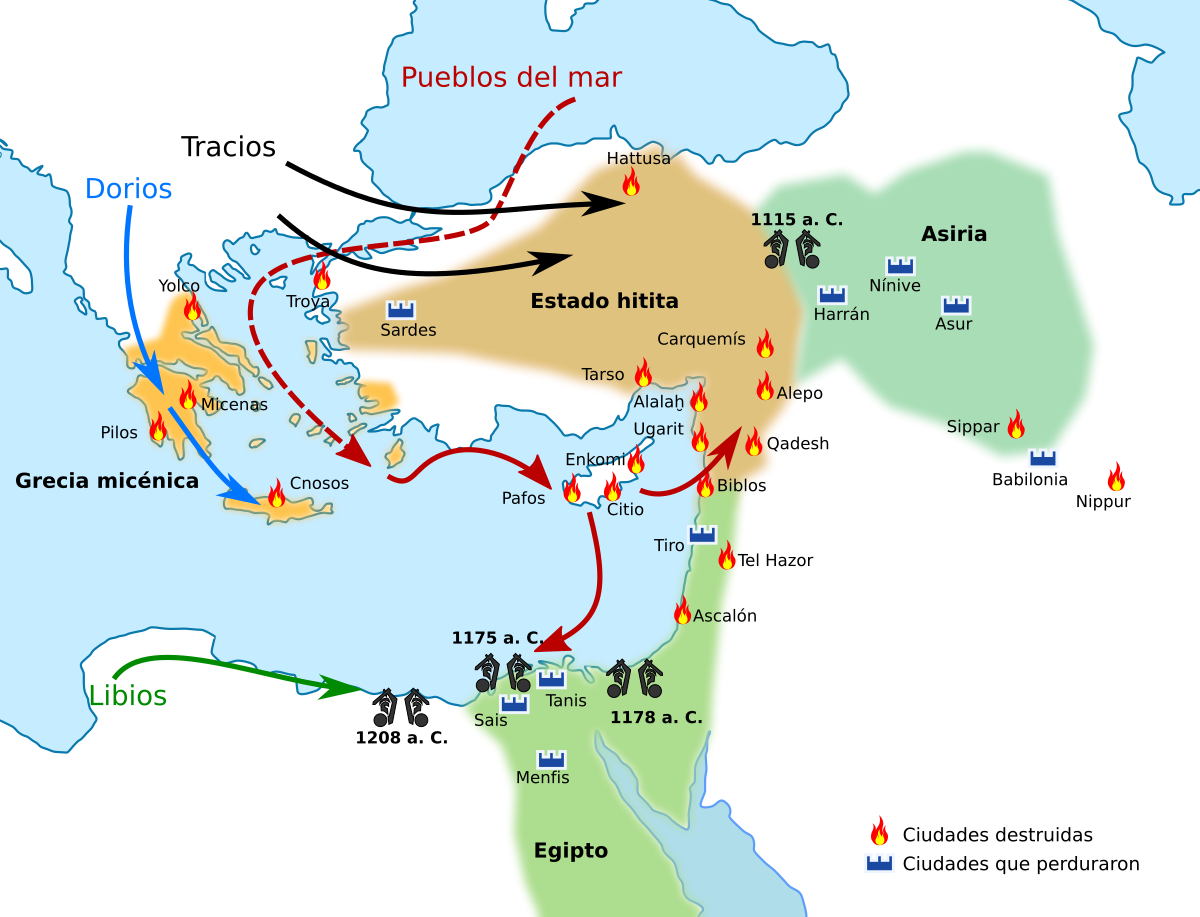Origin of the Goths and other ancient civilizations
The origin of the Goths, Phrygians, trojans, molting, Scythians, Philistines, Sardis…
Summary of contents of this page:
It is known that the writer Mark Twain was a man without equal. One more time, I agree that you were absolutely right when you said: ” It is easier to lie to people than to explain to them that they have been deceived. “. Samuel Butler (1835-1902) is the author of a very interesting statement that makes you think. about a century and a half ago, the British intellectual said: “Not even God can change the past, but historians can”. Along the same lines is Napoleon Bonaparte's statement: “History is a collection of lies that everyone has accepted”. These grandiloquent phrases are rescued in this article to advance the hidden truth about the origin of the Goths and other ancient civilizations. An uncomfortable truth that is difficult for many to accept, either out of pride, for mere economic interest or simply for ignorance of the signs of the past.
Origin of the Goths.
Like most I have always considered the Gothic peoples as a people of Germanic origin. After learning about the work of Gancho Tsenov (1870-1949) “The origin of Bulgaria and the Christianization of the Bulgarians”, I realized that not only me, but to everyone, they lied to him about the true origin of the Goths. Gancho Tsenov after living his youth in Bulgaria ended up being a professor of ancient history at the Humboldt University in Germany. Tsenov's basic writings were published in Germany and in Bulgaria, In fact, his works can be found on online book sales platforms written in German.. Tsenov promoted the idea that the Bulgarian nation is one of the oldest in Europe and that the Goths, that shook Rome and Constantinople, they are an old people tracking known as Getas (Getty or Gets in English).
Later, in 2008, thanks to the work of Professor Asen Chilingirov, “Getty y Goth”, I learned important details about how the history of the Getas was distorted and falsified to suit the interests of some countries. The Getas are key people in European history because they are the founders of the culture of the Slavs and Germans of northwestern Europe., as historian Nikola Yonkov Vladikin explained a century ago.

geta warrior. Author: Mariusz Kozik
The language spoken by these people from the Geta tribe is identical to the language of the ancient Bulgarians, whose former name is Mizi or Missi. This is the reason why the two groups, Getites and Thracians mix amazingly quickly and seamlessly, a fact attested to by the famous geographer and historian Strabo: ” Aelius Catus, Roman commander, ordered to take the lands beyond the South of the Danube to 50.000 Geta tribe people (goths) – tribe that spoke the same language as the Thracians who inhabited that region, he established them in Thrace and now they call themselves the tribe of the Moesi . Source: http://penelope.uchicago.edu/Thayer/E/Roman/Texts/Strabo/7C*.html
The common roots and the identical language of the Bulgarians and the brittle, also called goths, is the reason to identify the Bulgarians with the Goths as Herodotus does. Herodotus wrote about them giving information about the Persian campaign against the Scythians: (Source: herodotus iv, 93) “The lands north of the Danube are the traditional territory of the bravest warriors and, at the same time, the fairest thracians: the Getas”.
five centuries later, Strabo presents valuable information about the Getas and their wise Zalmoxis who was a Thracian. And in the fourth century after Christ, Jerome of Stridon (St Geronimo) mentions the Getas and specifies that they are Christians (like the Thracians, that is to say that the getas did not worship pagan or Nordic gods).
Fortunately, there are scientists like the Swedish archaeologist Klas Vilhelm Erik Nylén (1918-2017) giving information about the Thracian origin of the silver cauldron found at Gundestrup, Denmark, known for it as “The Gundestrup Cauldron”. This large cauldron was in the possession of a tribe of Goths that occupied this part of Northern Europe.. The cauldron, richly decorated, it is considered a gift between tribes “sisters”: Bulgarian Thracians and Central European Goths.

Gundestrup Cauldron. cultural Google photo. Copenhagen Museum
We also have Georgi Sotirov's research, who proved that the name of the sea surrounding Denmark, known in ancient times as Mori Marusa, is a name of Bulgarian origin and literally has the meaning of “rime sea”, that is to say, frozen. These data show that in the distant past, the spread of culture was from the Balkans to the North, not the other way around as it is more widespread to think about it. It is time to start establishing that the origin of the Goths is in the Balkans and not in Northern Europe.. Source: https://sparotok.blogspot.com/2019/12/blog-post_19.html?m=1
There are several signs that tell us about the origin of the Goths, but they have been hidden and discredited for many years.
Phrygians.
The ancient Bulgarians are characterized by something rather unusual. They practiced the artificial cranial deformity that produced skulls taller than normal. This is not a strange practice in the Balkans, dates back to the Stone Age as mentioned by Yordan Yordanov, anthropologist and director of the Institute of Morphology and Experimental Anthropology of the Bulgarian Academy of Sciences. Russian archaeologist Alexander Mongait (1915-1974) writes about an artificial cranial deformity among the population of the Black Sea steppes since the Bronze Age.

Sculpture depicting a Pelasgian found in Asia Minor. The artificial cranial deformation practiced by these tribes is observed.
In 1957, an American team excavated the tomb of the Phrygian king Midas who ruled in the period between the 740 a. C. and the 696 a. C., about. King Midas is known worldwide because according to Greek mythology, The monarch was cursed to turn everything he touched into gold.. It turns out that the remains found of King Midas were quite strange due to the artificial deformation of his skull.. Although the American archaeologists who found this find postponed its publication for more than twenty years, at least until the end of the decade 1980, by then it was well known that the Phrygians and other Thracians practiced artificial cranial deformation. In the year 2000, Stefan Yordanov mentioned in his post “The Thracian Warrior” that some of the established Thracian tribes in Asia Minor were familiar with cranial deformation. Twenty years later, no one is interested in pointing out the artificial cranial deformity as a common feature between the ancient Bulgarians and the Phrygians, another truth that wants to be hidden as in the case of the origin of the Goths. Source: https://sparotok.blogspot.com/2019/05/blog-post_30.html?m=1
trojans.
Homer's information about Thracian culture allows us to know a period before its apogee. The finds in the region of Phrygia (current Turkey) make it clear that the Trojans are one of the descendants of the Thracian-Phrygian tribes of Asia Minor.
The progressive scientist D.P.. Daskalov connects the past of the Thracians glorified by Homer and their relatives the Trojans, and he has every right to do so because there is evidence in the material culture to testify that the ancestors of the Bulgarians were the first civilized inhabitants of Troy. Ancient proper names used in Troy: Those, Ida, Sky, Kamander, Seleya have parallels in Thracian onomastics and their meaning can be explained in Bulgarian. Source: https://sparotok.blogspot.com/2019/01/blog-post.html?m=1
The objects found in Troy with signs have no parallels in any other culture than the runes of the ancient Bulgarians., the Thracians. From which it follows that Trojans and Thracians used the same language. Unfortunately, there is grave silence on this issue.
Trojan Sign Comparisons (left column) with ancient bulgarian runes (right column) where it is clearly seen that they are practically the same. Source: https://sparotok.blogspot.com/2018/08/blog-post_30.html?m=1


Huns and Scythians.
the huns (Atilla) and Scythians were Thracian tribes north of the Danube, They didn't come from the East, Mongolia, nor from Asia Minor as is widely thought, but they were groups settled from their beginnings north of the Danube and of Thracian origin. Source: https://sparotok.blogspot.com/2019/09/blog-post.html?m=1
In 1912 D.P's work came out. Daskalov “Scythian and Sarmatian ancestors of Slavs and Bulgarians”. It refers to the Thracian origin of Sarmatians and Scythians. It is also important what was indicated by Stephen of Byzantium, 6th-century Greek lexicographer, author of an important geographic-ethnic-philological dictionary and index called “Ethnika” in which he identified the Thracian people as Scythians.
Below is a fragment of the Etnika of Esteban de Byzantium, clearly visible wrote: “the scythians are a thracian people”. Source: https://sparotok.blogspot.com/2019/01/blog-post.html?m=1
Fragment of the Etnika of Stephen of Byzantium
Not just DP. Daskalov identifies the Thracians with the Sarmatians, according to Procopio de Sázava (Bohemia 970-1053): “the Sarmatians belonged to the family of the Northern Thracians, the Getas”.

Scythian warriors on horseback
It is not strange that these researchers identify Thracians with Scythians and Sarmatians. We know that they had common customs such as their attachment to horses to the point that when the aristocrats of these tribes died they were buried under burial mounds with their horses or common clothing such as the typical Thracian cap shown in the illustration above..
Philistines and Sardinians.
If we impartially observe the historical events of the end of the second millennium BC, can we answer the above question. Between the 14th and 12th century BC. due to severe and rapid climate change many people who inhabited the Balkan Peninsula are forced to emigrate. being a minority , the former emigrants from the Balkans were assimilated by the peoples of the East, but nevertheless contributing new blood and, Of course, knowledge. From the mixing of the ancestors of the Bulgarians with the Canaanites, the phoenician people arose. Thanks to the ancient writing of the Thracians, the phoenician alphabet was formed . Source: https://sparotok.blogspot.com/2017/10/to.html?m=1
During this period between the fourteenth and twelfth century BC., many ancestors of the Bulgarians migrated to Asia Minor, but the migrant population that fled natural disasters was too large and they had to head further south, reaching even to Egypt. Due to their large number and strong army, they represented a threat to the country of the pyramids and were not well received.
The pharaohs Ramses II , Merenptah and Ramses III , they waged long wars with these Thracian emigrants who were very difficult to defeat in combat. Possibly, Nevertheless, the Egyptians succeeded in dividing these ancient Balkans, giving land to some and pitting them against each other, some factions of this Thracian group were rejected by their own comrades and forced to settle in isolated parts of the Sinai, as well as in the territories of present-day Israel (the Gaza Strip), Lebanon, Jordan, Syria. Hence it follows that the Philistines of Gaza are of Pelasgian origin.. Source: https://sparotok.blogspot.com/2019/07/blog-post_11.html?m=1
In this way Pharaoh Merenptah saved Egypt from the Thracian invasion (known to the Egyptians as the Sea Peoples), by giving them land to colonize in North Africa, As long as they fight by your side. The tactics were successful and the march of the Peoples of the Sea was stopped.

invasions of “The Peoples of the Sea”
the pelasgians (Thracian ancestors) who were rejected returned from Egypt and settled in a land that would be called Palestine after their arrival (hence the similarity between the words Palestine-Pelishtim-Pelasgians). Some of the relatives of the Pelasgians took their ships to the West and settled on an island, to which they gave their name. Is about sardinia , These Pelasgian relatives who settled there were called by the Egyptians by the name Shardunash or Sherden and hence the name of the island of Sardinia. .
A group of Sherden, known for his high military qualities , returned to the Balkans and became known as the Serdi tribe in ancient times . They are the people responsible for the origin of the name Serdica, former name of the current capital of Bulgaria, Sofia. The Romans also knew this city by the name of Serdica and that is how it appears on their maps..
Influence in Spain.
Why are words from the language of the ancestors of the Bulgarians present in the language of the indigenous peoples of the Spanish Levant?. For example, in present-day Bulgaria, the most important river that crosses the country is called Maritsa., although in ancient times it was known by the Thracian name Ebros (Source: Maritsa – Wikipedia, The free encyclopedia ) therefore almost identical name to the main river that pours its waters in the Spanish Levant, the Ebro river. The Maritsa River in Bulgaria takes its waters from the Rila Mountains which of course we recommend you visit if you travel to Bulgaria.

Maritsa River, formerly called Ebrus River, from which the river Ebro in Spain takes its name.
Regarding the genetic studies, the haplogroup I2 present in Spain and Portugal coincides with that of the current Bulgarians, how is it possible that genetic similarities are found in opposite corners of Europe?… Well, it is well known that the Visigoths who founded their kingdom in the Iberian Peninsula are descendants of the Getas. (goths), described by Herodotus as Thracians, so everything fits. There is nothing strange about sharing genetic inheritance, nothing mysterious.
That's how simple things are. That's how easy it is to explain the fact that in Bulgarian, Spaniards and Sardinians the concentration of haplogroup I2 is quite high. No complicated terms needed, you don't need a huge bibliography. It is only necessary to use historical sources, as well as archaeological data, onomastics and genetics. So everything looks logical and fits.
I finish as a summary of what was explained above about the origin of the Goths, Phrygians, trojans, molting, Scythians, Philistines, Sardis, etc. with the statement given by the writer Upton Sinclair (1968-1978) :
” You can't explain something to someone if their salary depends on not understanding it. “…









Send a reply